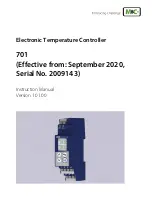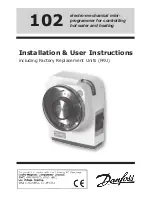
BAS-SVX084A-EN
59
Troubleshooting
Wired Zone Sensor Setpoint Failure
In the event that the Symbio 210 controller reports an incorrect zone setpoint, check the following:
•
Verify that the zone sensor is wired correctly.
•
Check that the zone sensor setpoint dial is not defective.
–
Disconnect the zone sensor terminal plug from the Symbio 210 controller and using an
ohmmeter, measure the resistance across the terminals 2 (common) and 3 (setpoint).
Compare the resistance to specified setpoint on sensor using
. The resistance
shown should correlate within ± 2 degrees of setpoint. If not, replace the zone sensor.
•
Check the wiring and the Symbio 210 controller.
–
With the wires still connected to Symbio 210 controller, disconnect zone sensor setpoint
wires and check voltage (direct current) from wires that were connected to terminals 2 and
3 of zone sensor. Measure for 2.6–3.0 Vdc and if not present, then verify whether the Symbio
210 controller is outputting 2.6–3.0 Vdc.
To do this, disconnect the wires on the Symbio 210 controller on terminals Ground
and
AI2 and measure the Vdc– it should be 2.6–3.0 Vdc. If there is 2.6–3.0 Vdc at the Symbio 210
controller, the wires going to the zone are OPEN. If 2.6–3.0 Vdc is not present, check the
incoming power to the Symbio 210 controller on XFMR 24 Vac input and
. It should
measure 24 Vac ± 15%. If the proper voltage is measured at the XFMR 24 Vac input and
,
and there is no voltage at the
and AI2, replace the Symbio 210 controller.
•
Verify that the zone sensor setpoint is not shorted out.
–
Check the resistance across the wires. Disconnect wires from the Symbio 210 controller and
zone sensor making sure the ends are not touching each other and measure resistance. It
should be infinity or no conductivity. If lower resistance is shown, then the wires are shorted
together and need replacing.
WARNING
Hazardous Service Procedures!
The maintenance and troubleshooting procedures recommended in this section of the manual
could result in exposure to electrical, mechanical or other potential safety hazards. Always
refer to the safety warnings provided throughout this manual concerning these procedures.
When possible, disconnect all electrical power including remote disconnect and discharge all
energy storing devices such as capacitors before servicing. Follow proper lockout/tagout
procedures to ensure the power can not be inadvertently energized. When necessary to work
with live electrical components, have a qualified licensed electrician or other individual who
has been trained in handling live electrical components perform these tasks. Failure to follow
all of the recommended safety warnings provided, could result in death or serious injury.
















































